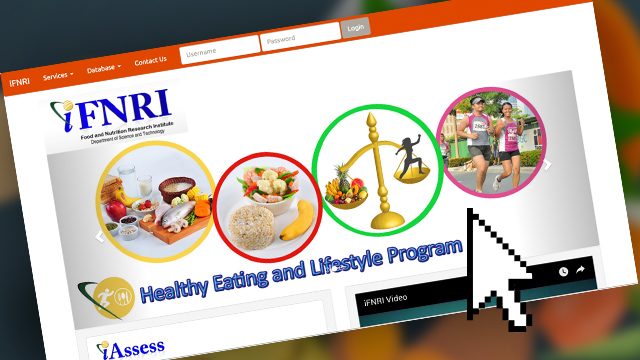SUMMARY
This is AI generated summarization, which may have errors. For context, always refer to the full article.

MANILA, Philippines – Jose Salonga, an indigenous leader, described his community’s diet: a mix of rice, vegetables, root crops, and the odd piece of wild boar’s meat, depending on what’s available. (READ: Indigenous vegetables and the Filipino diet)
Compared to those in urban areas, residents in rural places like Barangay Kanawan in Morong, Bataan, tend to eat more starches, cereals, and vegetables. (READ: What are the top 20 food products consumed by Filipinos?)
However, many of them still go hungry. The Food and Nutrition Research Institute (FNRI) wants to change that.
The FNRI and the Department of Science and Technology (DOST) think they can kickstart the solution using technology – a website to give nutrition information a wider reach.
FNRI Director Mario Capanzana said that launching a website, dubbed iFNRI, brings the government is one step closer to making food and nutritional data available to all. This includes everything from the nutritional content of food items to the institute’s updated national surveys.
Monitoring and tailoring
But what does this mean for people like Salonga?
Capanzana used the banana as an example. He said such information would make it easier to tell how healthy or unhealthy the banana, or any kind of food, is.
“If they have Internet access or know how to use the Internet, they can easily log in and see how much nutrients are present in a banana,” he explained in a mix of English and Filipino.
The implications of an information and communications technology approach go beyond looking up the nutritional value of a banana, according to Capanzana.
Online health advice from FNRI allows households, schools, and local health centers to monitor body mass index and other vital signs to decide on how to tailor diet and exercise to each person’s needs.
A teacher or mother anywhere with Internet access can input their students’ or children’s height and weight to see if they are overweight, underweight, or normal, before planning a regimen to address health concerns, with FNRI’s online counseling.
Although iFNRI’s audience is broad, Capanzana said schools would be the biggest beneficiaries because of the module on recipe development, which calculates the nutrient content and price of dishes.
Child malnutrition rates in the Philippines have remained virtually unchanged. Overweight children are common in urban areas while underweight, stunted, and wasted children are prevalent in rural communities.
Moving forward
While it is easy to get excited about the new technology, Capanzana admitted the website has limitations, primarily reliable Internet connection, and access, in rural areas.
“We need to come up with high-speed Internet access. Hindi naman high ang speed, but enable ma-load yung [website] (The speed does not necessarily have to be really high, just enough for the website to load),” Capanzana added.
As a whole, the Philippines’ Internet download speed is below the global average at 3.7 megabits per second (mbps) compared to the 24.2 mbps average global internet speed.
In 2015, the National Telecommunications Commission signed a memorandum stating that “broadband” services must be 256 kilobits per second.
Not all hope is lost for rural communities.
“What’s important is there’s already a platform they can access,” Capanzana said. He added that the next step is “to reach out to areas where there is limited access to the Internet.”
Improving the country’s Internet is already in the DOST’s plans, according to Capanzana.
He expressed optimism about the future of the project. “Well, the DOST is looking at making Internet available in selected public areas and even rural areas. So through the project it will make the internet accessible for everyone, even in the rural areas maybe that’s the next program that needs to be enhanced, but in anticipation of that here we are, we have the platform.” – Rappler.com
Add a comment
How does this make you feel?
There are no comments yet. Add your comment to start the conversation.